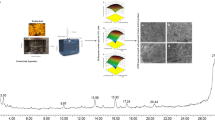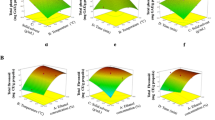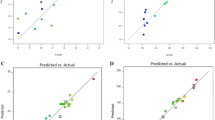Abstract
Key message
Sweet cherry tree branches have important food and medicinal value. The ultrasound and microwave-assisted extraction method is more efficient with higher yield than conventional extraction methods (heat-reflux, Soxhlet, etc.).
Abstract
Plant byproducts are known as sources of natural bioactive compounds. The objective of this study was to rationally use sweet cherry tree branches (SCTB) discarded during pruning. Ultrasonication and microwaves are considered green techniques, and an ultrasound and microwave-assisted extraction (UMAE) method was established to obtain extracts from SCTB by response surface methodology. A mathematical model was established using the Box–Behnken design, and the effects of various factors and their interactions were analyzed as well. Taking the yield (w/w) as the objective, the optimal process conditions for UMAE of SCTB were 56 mL·g−1 liquid–solid ratio, 34 min extraction time, and 40–50 mesh particle size. The yield of SCTB extracts was 5.02%, which was close to the theoretical prediction. The optimized extraction process can obtain a higher yield than that of conventional extraction methods. The chemical composition of the extracts was identified by HPLC–MS/MS, and 400 metabolites, including carboxylic acids and derivatives (29%), fatty acyls (19%), organooxygen compounds (15%), flavonoids (12%), benzene and substituted derivatives (12%), phenols (8%), and imidazopyrimidines (5%), were annotated and classified. L-arginine and mannitol were the main chemical components of the SCTB extracts, suggesting their potential uses in the food and medical industries.
Graphic abstract





Similar content being viewed by others
References
Acero N, Gradillas A, Beltran M, Garcia A, Munoz MD (2019) Comparison of phenolic compounds profile and antioxidant properties of different sweet cherry (Prunus avium L.) varieties. Food Chem 279:260–271
Amatya S, Karkee M, Gongal A, Zhang Q, Whiting MD (2016) Detection of cherry tree branches with full foliage in planar architecture for automated sweet-cherry harvesting. Biosys Eng 146:3–15
Chupin L, Maunu SL, Reynaud S, Pizzi A, Charrier B, Bouhtoury FC (2015) Microwave assisted extraction of maritime pine (Pinus pinaster) bark: Impact of particle size and characterization. Ind Crops Prod 65:142–149
Chuyen HV, Nguyen MH, Roach PD, Golding JB, Parks SE (2018) Microwave-assisted extraction and ultrasound-assisted extraction for recovering carotenoids from Gac peel and their effects on antioxidant capacity of the extracts. Food Science & Nutrition 6:189–196
Delazar A, Nahar L, Hamedeyazdan S, Sarker SD (2012) Microwave-assisted extraction in natural products isolation. Methods Mol Biol 864:89–115
Dziadek K, Kope A, Czaplicki S (2018) The petioles and leaves of sweet cherry (Prunus avium L.) as a potential source of natural bioactive compounds. Eur Food Res Technol 244:1415–1426
Gu Y, Ren K, Wang L (2020) Rg1 in combination with mannitol protects neurons against glutamate-induced ER stress via the PERK-eIF2 α-ATF4 signaling pathway. Life Sci 263:118559
Hassan AM, Mohamed HE (2019) L-arginine pretreatment enhances drought resistance of sunflower (Helianthus annuus L.) plants by increase in polyamines content. J Plant Growth Regul 38:600–605
Khan N, Bano A, Rahman MA, Guo J, Kang Z, Babar MA (2019) Comparative physiological and metabolic analysis reveals a complex mechanism involved in drought tolerance in chickpea (Cicer arietinum L.) Induced by PGPR and PGRs. Scientific Reports 9:2097
Kunthakudee N, Sunsandee N, Chutvirasakul B, Ramakul P (2020) Extraction of lycopene from tomato with environmentally benign solvents: Box-Behnken design and optimization. Chem Eng Commun 207:574–583
Lianfu Z, Zelong L (2008) Optimization and comparison of ultrasound/microwave assisted extraction (UMAE) and ultrasonic assisted extraction (UAE) of lycopene from tomatoes. Ultrason Sonochem 15:731–737
Martino E, Ramaiola I, Urbano M, Bracco F, Collina S (2006) Microwave-assisted extraction of coumarin and related compounds from Melilotus officinalis (L.) Pallas as an alternative to Soxhlet and ultrasound-assisted extraction. J Chromatogr A 1125:147–151
Mason TJ, Chemat F, Vinatoru M (2011) The extraction of natural products using ultrasound or microwaves. Curr Org Chem 15:237–247
Mohammadhosseini M (2017) Essential oils extracted using microwave-assisted hydrodistillation from aerial parts of eleven artemisia species: chemical compositions and diversities in different geographical regions of Iran. Records Natural Products 11:114–129
Muccillo L, Colantuoni V, Sciarrillo R, Baiamonte G, Guarino C (2019) Molecular and environmental analysis of Campania (Italy) sweet cherry (Prunus avium L.) cultivars for biocultural refugia identification and conservation. Scient Rep 9:6796
Nayak B, Dahmoune F, Moussi K, Remini H, Dairi S, Aoun O, Khodir M (2015) Comparison of microwave, ultrasound and accelerated-assisted solvent extraction for recovery of polyphenols from Citrus sinensis peels. Food Chem 187:507–516
Noiraud N, Maurousset L, Lemoine R (2001) Identification of a Mannitol Transporter, AgMaT1, in Celery Phloem. Plant Cell 13:695–705
Oancea S, Grosu C, Ketney O (2013) Conventional and ultrasound-assisted extraction of anthocyanins from blackberry and sweet cherry cultivars. Acta Chim Slov 60:383
Porto CD, Porretto E, Decorti D (2013) Comparison of ultrasound-assisted extraction with conventional extraction methods of oil and polyphenols from grape (Vitis vinifera L.) seeds. Ultrason Sonochem 20:1076–1080
Rezende YRRS, Nogueira JP, Taís OMS, Barros RGC, Narain N (2020) Enzymatic and ultrasonic-assisted pretreatment in the extraction of bioactive compounds from Monguba (Pachira aquatic Aubl) leaf, bark and seed. Food Res Int 5:109869
Rice T, Sahin AW, Lynch KM, Arendt EK, Coffey A (2020) Isolation, characterisation and exploitation of lactic acid bacteria capable of efficient conversion of sugars to mannitol. Int J Food Microbiol 321:108546
Routray W, Orsat V (2012) Microwave-Assisted Extraction of Flavonoids: A Review. Food Bioprocess Technol 5:409–424
Şahin S, Samlı R (2013) Optimization of olive leaf extract obtained by ultrasound-assisted extraction with response surface methodology. Ultrason Sonochem 20:595–602
Sofia C, Rob S, Silva AP, Berta G (2018) Factors affecting quality and health promoting compounds during growth and postharvest life of sweet cherry (Prunus avium L.). Front Plant Sci 9:2166
Thompson MR, Douglas TJ, Obata-Sasamoto H, Thorpe TA (2010) Mannitol metabolism in cultured plant cells. Physiol Plant 67:365–369
Vélëz H, Glassbrook NJ, Daub ME (2008) Mannitol biosynthesis is required for plant pathogenicity by Alternaria alternata. FEMS Microbiol Lett 1:122–129
Velickovic DT, Milenovic DM, Ristic M, Veljkovic VB (2008) Ultrasonic extraction of waste solid residues from the Salvia sp. essential oil hydrodistillation. Biochem Eng J 42:97–104
Vernès L, Vian M, Chemat F (2020) Ultrasound and microwave as green tools for solid-liquid extraction. Liquid-phase extraction. Avignon University Press, Avignon, pp 355–374
Vursavu K, Kelebek H, Selli S (2006) A study on some chemical and physico-mechanic properties of three sweet cherry varieties (Prunus avium L.) in Turkey. J Food Eng 74:568–575
Xiang Z, Wu X (2017) Ultrasonic-microwave assisted extraction of total flavonoids from scutellaria baicalensis using response surface methodology. Pharm Chem J 51:318–323
Xu W, Chu K, Li H, Zhang Y, Zheng H, Chen R, Chen L (2012) Ionic liquid-based microwave-assisted extraction of flavonoids from Bauhinia championii (Benth.) Benth. Molecules 17:14323–14335
Yin C, Fan X, Fan Z, Shi D, Gao H (2018) Optimization of enzymes-microwave-ultrasound assisted extraction of Lentinus edodes polysaccharides and determination of its antioxidant activity. Int J Biol Macromol 111:446–454
You R, Zhou W, Li Y, Zhang Y, Zhang A (2020) Inhibition of ROCK2 alleviates renal fibrosis and the metabolic disorders in the proximal tubular epithelial cells. Clin Sci 134:1357–1376
Yu J, Lou Q, Zheng X, Cui Z, Fu J (2017) Sequential combination of microwave- and ultrasound-assisted extraction of total flavonoids from Osmanthus fragrans Lour. Flowers Molec 22:2216
Zanousi MBP, Nekoei M, Mohammadhosseini M (2016) Composition of the essential oils and volatile fractions of Artemisia absinthium by three different extraction methods: Hydrodistillation, solvent-free microwave extraction and headspace solid-phase microextraction combined with a novel QSRR evaluation. J Essential Oil Bear Plants 19:1561–1581
Zhang H, Li Q, Qiao G, Qiu Z, Wen Z, Wen X (2020) Optimizing the supercritical carbon dioxide extraction of sweet cherry (Prunus avium L.) leaves and UPLC-MS/MS analysis. Anal Methods 12:1–36
Zou Y, Jiang A, Tian M (2015) Extraction optimization of antioxidant polysaccharides from Auricularia auricula fruiting bodies. Food Sci Technol Int 35:428–433
Acknowledgements
The research was supported by grants from the National Natural Science Foundation of China (No. 31760191), Natural Science Research Project [2017]011 of Education Department of Guizhou Province, P. R. China, and Scientific Research Project for Guangxi Science and Technology Major Project (AA17204087-6).
Author information
Authors and Affiliations
Corresponding authors
Ethics declarations
Conflict of interest
The authors declare no conflict of interest.
Additional information
Communicated by Fernandez-Marin.
Publisher's Note
Springer Nature remains neutral with regard to jurisdictional claims in published maps and institutional affiliations.
Supplementary Information
Below is the link to the electronic supplementary material.
468_2021_2112_MOESM1_ESM.doc
Supplementary file1The following are available online: Fig. S1: Total ion chromatogram of the sweet cherry branches extracts (A. positive ionization mode; B. negative ionization mode). Table S1: Factors and levels in response surface design. Table S2. Chemical component identification (DOC 1390 KB)
Rights and permissions
About this article
Cite this article
Zhang, H., Yan, H., Lu, C. et al. Optimization of ultrasound and microwave-assisted extraction of sweet cherry tree branches and chemical component analysis by UPLC–MS/MS. Trees 35, 1247–1256 (2021). https://doi.org/10.1007/s00468-021-02112-z
Received:
Accepted:
Published:
Issue Date:
DOI: https://doi.org/10.1007/s00468-021-02112-z




